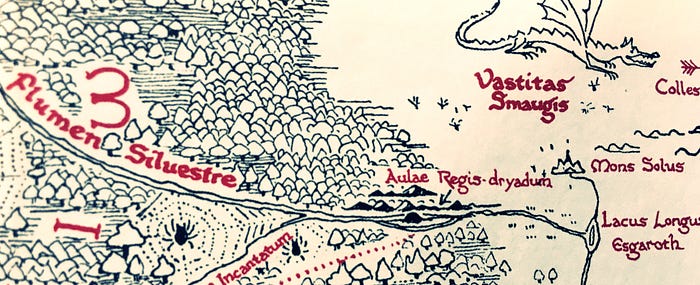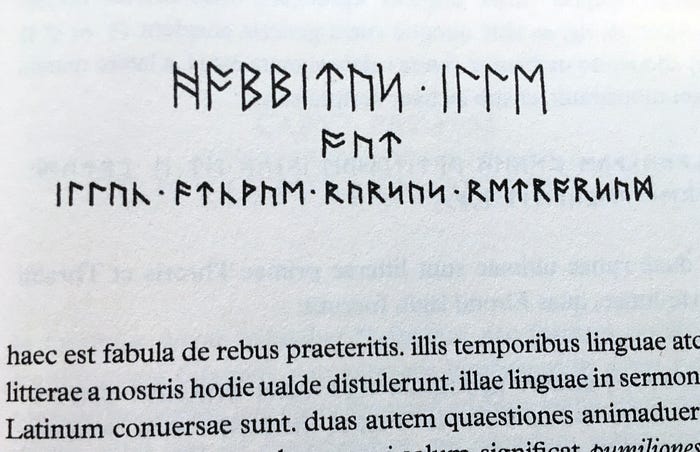Would Tolkien Approve of "The Hobbit" in Latin?
Considering Mark Walker’s Effort to Latinize Bilbo’s Adventures

In foramine terrae habitabat hobbitus…. So begins Chapter One of Hobbitus Ille, Mark Walker’s Latin translation of The Hobbit, published by HarperCollins in 2012. It is a handsome hardcover with an enticing dust jacket featuring J.R.R. Tolkien’s own artwork. Anyone who loves The Hobbit and Latin would, naturally, like to see them combined. But how good is the Latin? Caveat emptor!
Hobbitus Ille is a disappointing effort. The Hobbit deserves a translation of the highest quality, but the Latin in these pages often falls short. Although Walker’s text has some nice touches, they are overshadowed by a dismaying assortment of flaws. As a medievalist, I am untroubled by Latin that does not imitate Classical models, but I find this text troubling. It is at once overdue and premature: overdue because it should have appeared long before Harry Potter got the Latin treatment; premature because it suffers from insufficient editing.
The problems begin with the title, Hobbitus Ille, which seems to be inspired by Alexander Lenard’s Winnie ille Pu in its use of the demonstrative. While the decision is somewhat defensible because this Latin word evolved into the definite article in the Romance languages, why did the translator feel compelled to preserve a placeholder for the definite article when Latin does not require it, and why was it placed after the noun, contrary to typical Latin practice? These two initial decisions are emblematic of the cavalier attitude toward Latin norms that Walker displays throughout.

The problems continue in the subtitle. Walker renders “There and Back Again” as “Illuc atque rursus retrorsum,” apparently treating retrorsum as “back” and rursus as “again.” However, since rursus shares much of its semantic range with retrorsum, Walker’s rendition might be retranslated into English as a redundancy — “there and back backwards” — to the likely confusion of the “intermediate reader” (the intended audience for Walker’s translation; more on this below). Yet a word-for-word substitution does not seem desirable here. If “back again” can be treated as a single conceptual unit, as I think it should, it would be enough to render the subtitle simply as Illuc atque rursus. In fact, “back again” as a translation for rursus is precisely what we find in Lewis and Short, A Latin Dictionary, definition II.B. (p. 1607). One might also consider the standard Latin phrase, itus ac reditus, for this idea.
The foregoing examples suggest that the translator does not grasp the concept of idiom as well as one should hope. To be fair, he does much of the time, but the lapses are distracting or confusing. Would that all the flaws in Walker’s translation were merely debatable matters of personal preference! Unfortunately, his translation contains undeniable errors: numerous typographical lapses, some mistranslations, incorrect diction, omissions, and grammatical blunders. Before I address these failings in detail, I should consider the translator’s own introductory remarks.
Walker writes that the translation is intended to fill “the curious gap in the available reading material” for “the intermediate reader” who is “not quite ready to grapple with the stately poetry of Virgil or the grand rhetoric of Cicero” but “who just wants to read Latin … for fun” (p. V). The existence of a simplified paraphrase of the Hobbit for beginning Latin readers (by Anthony Gibbins, of Legonium) shows the demand for such materials. Unfortunately, the many problems in the text compromise its value for the inexperienced Latinist, certainly without a guide to point out the pitfalls. I offer my services to that end.
Here is just a sampling of typographical errors: p. XXIII: “erat” should be erant; p. XLIX “effractrius” should be effractarius (“burglar”); p. XCI: “tanget” should be tangit (present tense); p. XCVIII: “inuduet” should be induet (“will put … on”); p. XCVIII: “festinater” should be festinanter; p. CII: “paruum hobbitus” should be paruus hobbitus; p. CII: “currentum” should be currentem; p. CCXX: “gobelinourm” should be gobelinorum (“of the goblins”).
The grammatical errors are more disturbing. On p. XCIX: “suis” should be suorum; where Tolkien writes “of his own eyes,” Walker has “oculorum suis.” On p. CII: “tollent” should be tollebant (“bewildered goblins were still picking up his nice brass buttons…”). However, tollent (future tense) might be a typo for tollunt (present tense), since Walker has a habit of using the present tense alongside past tense verbs where Tolkien consistently uses past tense, and in places where the action is not vivid enough to invoke the historical present.
Some of the errors are particularly nasssty (my precious!). For example, where Tolkien writes of Gollum, “He still had a bone or two left…,” Walker translates, “ossa una aut dua … supersunt…” (p. XCIV). Disregarding the difference of tense, there are problems here. Ossa is plural, “bones,” and Walker recognizes the plurality in his verbal agreement; but una does not work with ossa any more than “one bones” is acceptable in English. And then there is dua — is this a typo for duo, the standard neuter form? Yet Walker consistently adopts “dua” for the neuter plural (cf. pp. XCV, CIV), either through ignorance of the standard form or out of a conscious decision to use the rare alternative form found “sometimes” in inscriptions (Gildersleeve and Lodge, Gildersleeve’s Latin Grammar, pp. 51–52, Section 95, Note 2). Surely intermediate readers should not be subjected to this.
There are mistranslations. Where Tolkien mentions dwarves “with blue hoods, silver belts, and yellow beards,” Walker translates “cum caligis caeruleis, cingulis aureis, et barbis flauis” (p. XXII); but caligis means “boots”; the translation should be cucullis. Furthermore, aureis means “golden”; the translation should be argenteis.
Walker also commits a few sins of omission (e.g., “and my legs ache” is not rendered where it should be on p. CX), which will confuse an intermediate reader who has the original open for comparison.

The stylistic problems are too involved to recount in much detail. I shall leave aside the poetry entirely and just mention a few conceptual issues that deserve attention. Walker has an odd fixation about transferring hyphens from the original into the Latin. The first example, “hobbit-hole,” also showcases a problem with diction. He selects foramen for “hole” in the famous opening line. Yet foramen is a hole in the sense of an “opening” or “aperture” (Lewis and Short, p. 766), i.e., a surface feature, such as an entrance or exit, rather than the comfortable space beyond; consider English “perforation.” A better word would have been cavum, which means “a hollow, cavity, hole” (L&S, p. 307; hence English “cave” or “excavation”). Compare Clive Harcourt Carruthers’ translation of Alice in Wonderland, where “rabbit-hole” (the perfect counterpart to “hobbit-hole”) is rendered “cuniculi cavum” (p. 1). Yet Walker translates “hobbit-hole” as “foramen-hobbitum,” as if his coinage “hobbitus” can be treated as a second declension noun or adjective. It would have made more sense to treat the newly minted adjective as third declension, hobbitalis, -e, just to avoid confusion. In any event, the hyphen is utterly unnecessary and undesirable. In the example cited above from Carruthers, Latin often performs the hyphen’s function with the genitive case. Thus, hobbiti cavum would make for better Latin. It would also be entirely appropriate to engage in a little Tolkienesque word-play (as per Tolkien’s coinage of “eleventy-one” for “one-hundred-eleven” in The Fellowship of the Ring, Bk. 1, Ch. 1) and derive “hobbitaculum” from habitaculum (“a dwelling-place, habitation”) or “hobbitatio” from habitatio (“a dwelling, habitation”; L&S, p. 835).
Walker does in fact use the genitive to qualify a noun in much of the text, along the lines of the example from Carruthers, but when doing so, he often inserts a superfluous hyphen between the genitive and its noun; and sometimes he fails to preserve the original’s hyphen, or he inserts a hyphen where there is none in the original (see p. CIX). Yet the most cringeworthy results occur when he combines an English prefix with a Latin word: “Bag-End” becomes “Bag-Finis” (p. XXIX) and “Mirkwood” becomes “Mirksilva,” which would have been better translated “Silva Tenebrosa” (here an adjective works), or the more Dantesque “Silva Obscura,” since “mirk” means “darkness” or “gloom” but functions as the adjective “dark” or “gloomy.” Despite the lack of a visible hyphen in “Mirkwood,” as a compound noun it performs much the same function. It should not be a compound noun in Latin.
Before concluding, a comment on the inhabitants of Middle-earth seems worthwhile. Walker asserts “Tolkien’s … story lends itself to … a Latin translation” (p. VI). To the contrary, I believe it poses numerous thorny challenges. A survey of its various peoples makes this clear, starting with the principal character, which of course has no Latin counterpart and must be coined. Walker’s solutions tend to be simple: “hobbit” is hobbitus; “troll” is trollum (plural trolla); “goblin” is gobelinus. Only in the last instance is there a precedent: the Oxford English Dictionary draws attention to “(apparently < French) post-classical Latin gobelinus (first half of the 12th cent. in a British source).” Had Walker preferred existing ancient Latin words (in this case old borrowings from Greek) for the latter two, he might have considered the cave-dwelling troglodytae for the goblins, and moriones for the trolls, since the transferred meaning of morio is “a monster, deformed person,” while its primary definition, “an arrant fool,” describes the slow-witted creatures rather well (L&S, p. 1165). But these suggestions admittedly have their own problems; which is precisely my point.
Walker adopts Latin words for “elf” and “dwarf.” The elves are dryades, i.e., “wood-nymphs” — an inspired choice given their habitat, but unacceptable because dryads in Greco-Roman mythology are strictly female; a male dryad is as scarce in Latin texts as a male Amazon. We seem on firmer ground with nanus for “dwarf,” except that a nanus was a diminutive human being, not a member of a separate race. The alternative, pumilio, has the same problem, although the proverb, “pumilio, licet in monte, non est magnus,” at least situates the mountain-dwellers in their proper habitat (Lewis and Short, p. 1491). Another choice might be Pygmaeus, although it poses its own problems. Finally, for Beorn the skin-changer, Walker adopts “mutator-pellis” (p. CXXVI), but could have used versipellis, which is as close to a native Latin word for “skin-changer” as one could hope for. Among the principal creatures, only dragon (draco) and eagle (aquila) are easily translated into Latin. In short, there are conceptual incompatibilities between the Germanic and Mediterranean mythologies that complicate the prospects for accurate translation.
Reading this translation of The Hobbit reminds me of reading a medieval manuscript, where one must always be on guard against the next scribal error; it becomes an exercise in tallying up the obstacles to comprehension. Surely The Hobbit deserved the finest treatment. After all, Tolkien was a philologist and a pious Roman Catholic in the days of the Latin Mass (and had trouble adapting to the vernacular Mass). He spoke Latin. He was a niggling perfectionist. What would he have thought of this translation?
Instead of guaranteeing the highest standards, Walker and HarperCollins have instead espoused the Chestertonian epigram: “If a thing is worth doing, it is worth doing badly.” Hobbitus Ille, in the final analysis, does not rise above the level of an unfortunate novelty item, rushed out by HarperCollins (after decades of neglect) without the kind of quality review that would accompany a text whose buyers might actually be expected to read it. Evidently a proper vetting of the translation would have cost the publishers more than they were willing to spend. The fact that the book sells well enough to still be in print attests to the accuracy of HarperCollins’ cost-benefit analysis. Thus, the publication is a testament equally to the power of marketing (selling the public something to have but not use, except as a shelf-ornament) and the ongoing enchantment that Latin continues to exert, even when the ability to read it has largely been lost.
The curio that is Hobbitus Ille can be ignored or engaged. Since many Tolkien-fans who also love Latin will encounter Walker’s translation, I propose the latter — to which end I am offering a Telepaideia course that will compare the translation to the original and provide guidance through a perilous linguistic maze. While I have misgivings about using Walker’s translation, the text has enough good passages, despite all its defects, to justify a closer look and see what works and what does not. Thus, the course will supply an opportunity to think about Latin idiom and to separate the bad passages from the good.
Robert Ziomkowski has degrees in History from Siena College (B.A., 1991), Cornell University (M.A., 1994; Ph.D., 2000), and the Pontifical Institute of Mediaeval Studies (L.M.S., 2002). His research focuses on medieval Platonism and cosmology. His publications include a translation and study of a text by the eleventh-century thinker Manegold of Lautenbach, as well as a study guide for Western Civilization and articles in the New Dictionary of the History of Ideas and PLOS ONE (“Mathematical Philology”). He attended Fr. Reginald Foster’s summer Latin course in 1994 while doing manuscript research in the Vatican Library, and his fascination with human languages has merged with an interest in computer languages (JavaScript, Python) for the creation of computerized Latin exercises. His other interests include animation and video editing; with his students at Ithaca College, he produced a short film in Latin on Homer’s Odyssey entitled Ulixes. This fall, he is teaching a course on this text, Classical Mythology, and Intensive Latin through Telepaideia.
Sign up to receive email updates about new articles


Comment
Sign in with